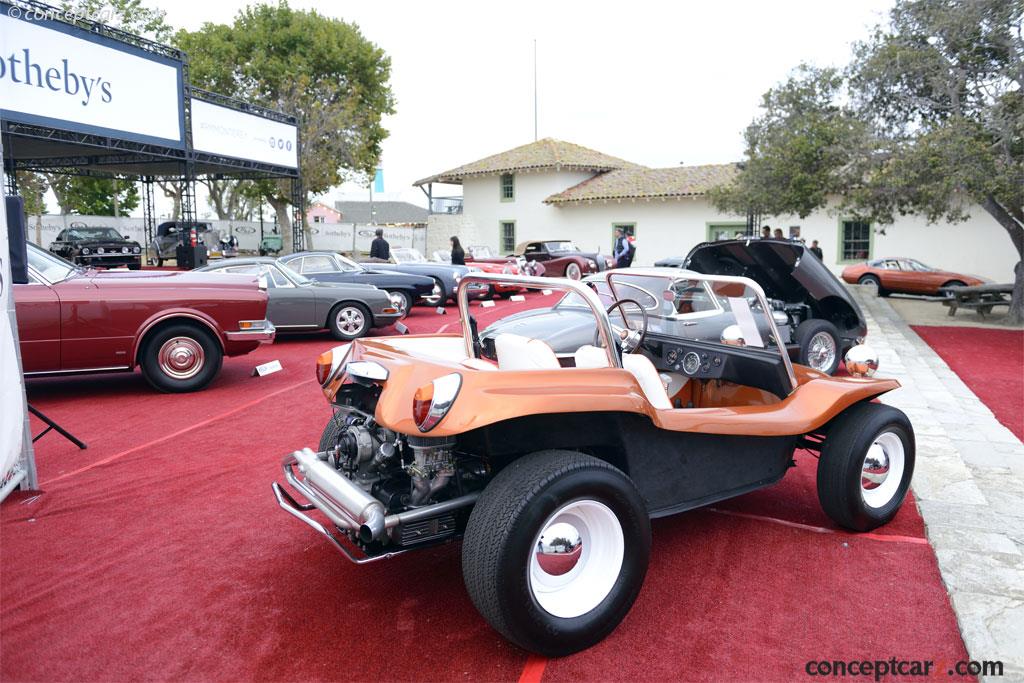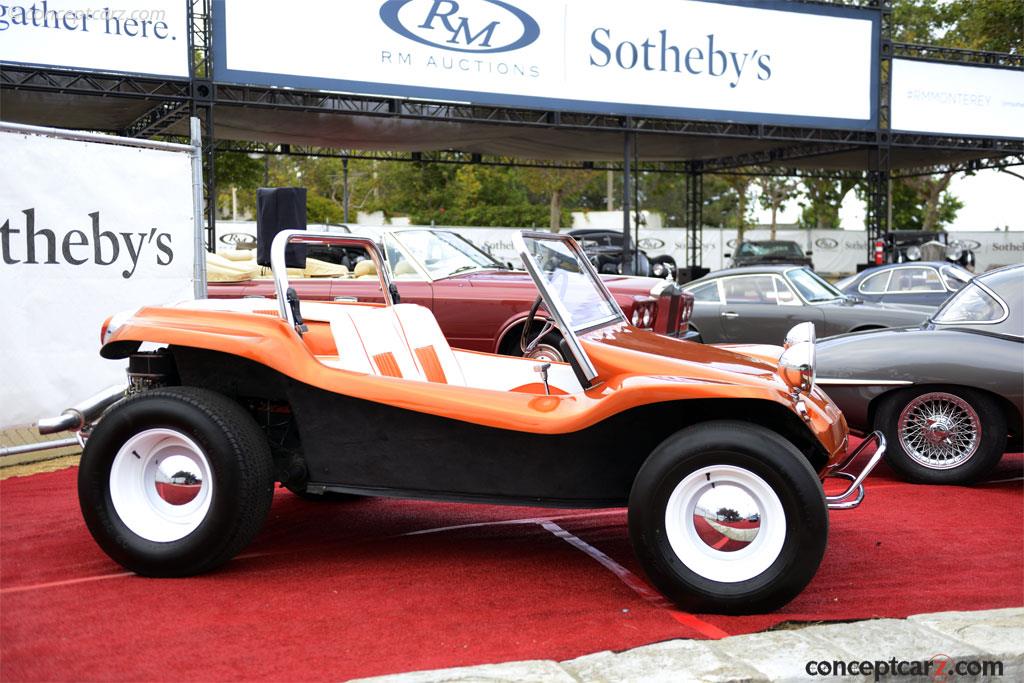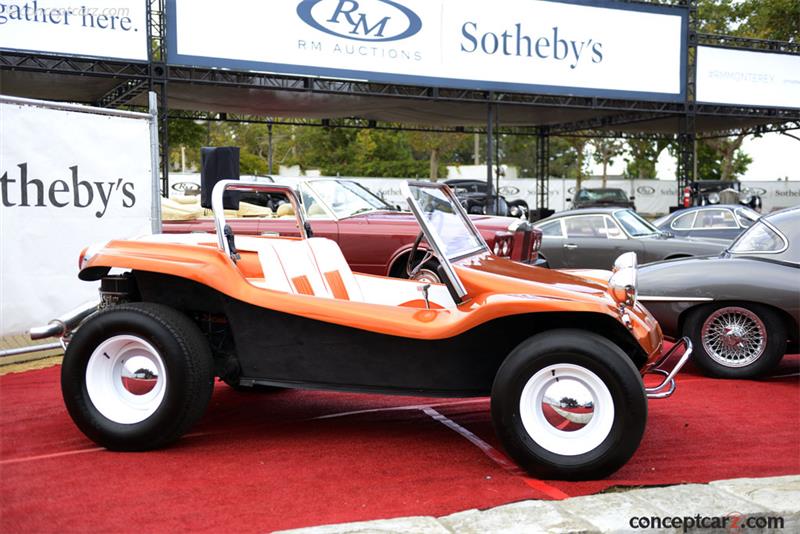Bruce Meyers grew up in Southern California during the early days of surfing, drag racing, and hanging out at the beach. Loving the lore of the sea, Bruce first enlisted with the Merchant Marines before serving his country in the Navy during World War II. Assigned to the Bunker Hill, an Essex-class Air Craft Carrier, Bruce was forced to jump from the ship when it was hit by two Kamikazes at the battle of Okinawa. After saving a burned pilot downed in the water, and though the ship was severely damaged, Bruce was one of the volunteer skeleton crew who went back aboard the smoking acrid, flesh-smelling hulk limping back to port.
Dune Buggy
Chassis #: 1102980174
View info and history
Auction entries : 2After the war, he sailed on a square-rigged ship to the South Seas to build a trading post in the Cook Islands for a very wealthy man. After six months on this coral atoll of Tongereva, Bruce completed the trading post amidst a tapestry of child-like people, pearl trading, and a steady diet of fish. He then spent six months in Tahiti before returning to the US. It was his love of sailing and the Polynesian lifestyle that later moved him to build his 42' catamaran, which he intended to sail back to the South Seas. The allure of Tahiti was not to be, however, and so Bruce went on to build tooling of the first fiberglass sailboats for the Cal-boat line of Jensen Marine designed by world-famous Bill Lapworth. It was at Pismo Beach, CA, that Bruce first became acquainted with 'dune buggies.' These 'water pumpers' were crude and heavy, so Bruce took it upon himself to design a lightweight version that would be fun on the beach or in the wilds of Baja. After modifying a VW Kombi bus with wide rims (called 'Little Red Riding Bus'), Bruce used his expertise in boat building to design the first fiberglass-bodied dune buggy, the Meyers Manx.The first 12 cars produced were all-fiberglass, monocoque bodies that had a steel structural frame within the fiberglass that attached to the VW suspension and running gear ('Old Red' - #1 now resides with Bruce). These cars were expensive (for their time) and redundant in that so much of the VW was thrown away. Bruce redesigned the body to fit on a shortened VW floorpan, which ultimately reduced the price as well. As a result, the Meyers Manx took off. It took the country by storm when magazines like Hot Rod and Car & Driver featured the fiberglass car on their covers. This caused a rash of over 300 orders. Not able to immediately fill these orders, other manufacturers sprang up overnight and ended up producing over 250,000 look-a-likes and near look-a-likes. Eventually, over 300 companies worldwide copied the Manx in one form or another – even the copiers copied each other. Bruce tried to stop the floodgate of imitations with patent infringement laws but failed to convince the judge that he had produced anything worth a patent. In subsequent years B.F. Meyers & Co. built 5,280 Manx kits, several hundred Manx 2's, about 1,000 Meyers Tow'ds, a couple of hundred Manx SRs and 75 Resorters - a total of nearly 7,000 kits. 
Dune Buggy
Chassis #: 1102980174
View info and history
Auction entries : 2The performance of the Meyers Manx was amazing, especially off-road! It handled better than any other off-road vehicle and was much more fun to drive due to its supple suspension and lightweight. A pair of Meyers Manx's won 39 out of 41 slalom races and won its class in the Pike's Peak Hill Climb beating Corvettes, Cobras, and most open-wheel sprint cars! The roots of off-road racing were the old motorcycle elapsed-time records. The very first Meyers Manx, 'Old Red' (driven by Bruce and Ted Mangels), beat these bikes by over five hours culminating in the first Baja off-road races. Meyers Manx's came in first overall and second in their class in the first official race, the Mexican 1000 - 1967. This started the off-road revolution and eventually the Score's Baja 1,000 off-road race. The Meyers Tow'd was originally produced for off-road use only. It was an effort to diversify and expand the B. F. Meyers & Co. product base. The original Tow'd, aptly named as it was to be towed (get it?), had no hood or fenders. People thought it was so cute that they demanded it also become street-legal. Eventually, the Towdster evolved adorned with hood, fenders, and engine cover – even a soft-top for weather protection. The Tow'd had production problems and never really caught on like the Manx. The body was smaller and lighter than the Manx and was built on a custom tube frame. One might say that the Tow'd was the predecessor of the modern sandrail. Bruce raced a Tow'd in the second Baja 1,000 and ended by crashing and breaking both legs. He is reminded daily by a worn-out stainless steel ankle today, which is detected by his slight limp.The next product of the company was the Manx SR (Street Roadster). This car was an attempt to short circuit the Manx copycats. Penned by Stewart Reed, a student fresh out of Art Center College of Design, it was intended for the street only and possessed a sleek aerodynamic shape that is still contemporary today. It was built to fit on the same shortened VW floorpan as the original Manx to keep the great handling characteristics. The car had thirteen fiberglass and many metal pieces making it much more of a challenge for the garage-type mechanic to complete. Though it was thought that there were 400 to 600 of these kits produced, it now appears more like 200 were sold by B.F. Meyers & Co. and possibly 200 more sold by the successive companies that bought the molds after the company went down.
Dune Buggy
Chassis #: 1102980174
View info and history
Auction entries : 2The Resorter/Turista was also produced by B.F. Meyers & Co, though not designed by Bruce, as a 4-seat tour vehicle. The Resorter had lower sides for easier entrance and exit. The car was originally produced and sold to hotel chains in Puerto Rico, Acapulco, and Hawaii. Bruce was not fond of its shape and claimed the sight of it gave him the 'turistas' ('Montezuma's Revenge').Three Utility cars were produced, two of which were sold as Lifeguard buggies for Los Angeles County and one buggy designated for the California Forestry Service. These buggies were equipped with a covered rear bed for hauling life-saving gear and which required the use of a VW 'pancake' engine. The third utility buggy intended for the Forestry Service was stolen from the company before it was ever delivered. It has only recently been rediscovered, though its history is still clouded in mystery.The last vehicle in the Manx fleet was the Kuebelwagen. This car was a replica of the German Desert Staff car of WWII and was built on a full-length floorpan. Sadly, there was only one of these cars built. Totally restored, this car reigns high in the Manx Club.In 1970, with the burden of fighting the cheap imitations of the copiers, cross-country shipping difficulties, the loss of the patent infringement case, demands of the rule changing Excise Tax Board, conflict within the company and an impending divorce, Bruce left B.F. Meyers & Co. for a less stressful life. Under the direction of John Blick, B.F. Meyers & Co. closed its doors in 1971. A public auction equivocated Bruce's dream at less than ten cents on the dollar.Now 35+ years later, Bruce and the Meyers Manx are back. Offering the new Manxter 2+2 and the Manxter DualSport, these street-legal fiberglass dune buggies are dreamed, designed and brought to reality by the man who started it all.Source - Meyers

Dune Buggy
Chassis #: 1102980174
View info and history
Auction entries : 2

Dune Buggy
Chassis #: 1102980174
View info and history
Auction entries : 2

Dune Buggy
Chassis #: 1102980174
View info and history
Auction entries : 2
1970 Meyers Manx Vehicle Profiles
Recent Vehicle Additions
Performance and Specification Comparison
Price Comparison
Related Automotive News
A Meyers Manx Collaboration with Artist Sage Vaughn Contributes $200,000 to Arts Education Fundraiser
The first vehicle in the commissioned series debuts at The Party at Crystal Bridges
A Meyers Manx Sage Vaughn Art car was up for auction at a recent Crystal Bridges Museum of American Art fundraising auction held in honor of Annie Liebowitz and...

BRUCE MEYERS TO CELEBRATE 50TH ANNIVERSARY OF ICONIC MEYERS MANX BY RACING IN 2014 NORRA MEXICAN 1000 RALLY
After months of preparation and with the support of an industry it helped create, Meyers Manx Inc. today proudly announced details of a new project to celebrate the cars 50th anniversary next month. It is entering company founder Bruce Meyers in next...

ROD HALL NAMED GRAND MARSHAL OF 2014 GENERAL TIRE NORRA MEXICAN 1000
-- Hall of Fame Racer To Be Part of The Happiest Race On Earth --
(Agua Dolce, Calif.) In celebration of his lifelong love affair with off-road motorsports, the Baja peninsula and an entire industry he helped to foster, racing legend Rod Hall...

BEACH CARS STORM THE 2014 AMELIA CONCOURS d'ELEGANCE
For an event like The Amelia a class of beach cars is appropriate and ideal, said Warner. After all, when you take a break from the concours field and sit on the veranda at the Ritz-Carlton with a cool drink in front of you, you stare at the ocean...

Norra Names Mark Mcmillin Grand Marshal For 2013 General Tire Mexican 1000
Legendary Baja racing champion and San Diego-based homebuilder Mark McMillin has been named by the National Off Road Racing Association (NORRA) as the honorary Grand Marshal for this years upcoming General Tire NORRA Mexican 1000. The unique fourth...

















